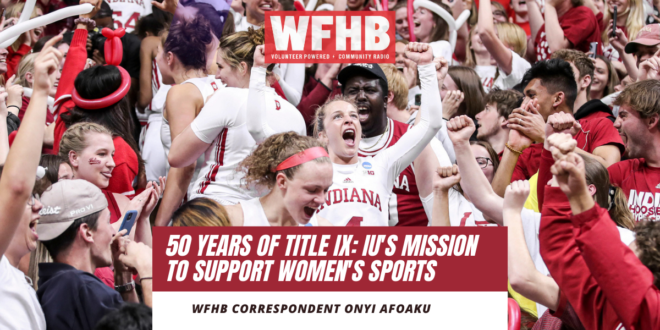Podcast: Play in new window | Download (Duration: 22:54 — 31.5MB)
Subscribe: RSS
It has been 50 years since Title IX, the federal civil rights law prohibiting sex-based discrimination from schools and educational programs receiving federal funding, was passed. Now that the landmark legislation has been around for half a century, it begs the question: where are things now?
In the year 2022, women’s collegiate athletics are still looking for equal funding and support. Female college athletes are also looking for better exposure to showcase their skills. Unfortunately, they are doing so in a society that is still behind when it comes to its views on the importance of women’s athletics. While society plays catch up, Indiana University is taking steps to make sure its women’s sports teams are well supported.
For many young women, sports are not just a game, but they are vehicles that foster healthy growth and development for young women and girls everywhere. According to Lauren Smith, a professor at Indiana University’s Media School who specializes in sports media, sports offer positive benefits to young girls on and off the field.

“There have been so many studies out there that talk about the benefits of sports for girls and young women with respect to confidence, mental health, and life building skills,” Smith said. “Female athletes end up being more confident, they feel better about themselves overall, they do better in school. So the benefit of sport, period, is definitely unmatched for women. With respect to IU’s [Women’s] Excellence Initiative, it seems like they’re taking those foundational things and helping to build those skills into areas other than just sport with respect to leadership training, with job training so that student athletes can take those skills, that confidence, those leadership skills and translate them into a real, practical experience that will continue to benefit them once they are no longer athletes.”
Title IX was meant to provide equal opportunities for men and women in collegiate sports. However, Smith points out that there is still work to be done.
“Title IX was implemented for opportunity. If you’re looking at Title IX you’re looking for equal opportunity for men and women in sport, that women are not limited by their gender; they are not punished by their gender. So overall, Title IX is supposed to support that equal opportunity. Does it? No. There have been a couple studies that have come out in the past couple months that show, despite being 50 years into Title IX, funding is still not equal. Universities across the country are still falling short of the mandates of Title IX. Even though that law is there, the opportunities still are not,” said Smith.
Even with such a law in effect, there is still a disparity between the amount of opportunity and funding. Smith says that women’s athletics have not gotten the opportunity to make up ground in comparison to their male counterparts.
“I don’t know that they’re necessarily left behind. I don’t know that they’re not being given the opportunity to catch up,” she said.
Women in collegiate sports are going up against more than just a gap in opportunities that women receive as opposed to men. Part of the problem stems from the attitudes of the public as well. According to Pew Research Center, 46 percent of women compared to 29 percent of men believe Title IX has not gone far enough to increase opportunity for women in sports. According to Smith, this is more obvious to women because they are the ones affected.
“I think female athletes look around in their own athletic departments and they see what the men get and what they get and they can tell with their own eyes that those opportunities are not equal,” said Smith.
Another significant statistic that the survey found was that 61 percent of Americans said that funding in men’s and women’s sports should be equal. A sizable portion, 21 percent, said that the funding should be based on the money brought in by the team. According to Smith there are several different flaws with these attitudes.
“They’re significantly behind. I think a lot of people will rest on that argument that if a women’s team in a women’s sport can’t bring money in, then they shouldn’t be deserving of equal pay, equal funding, and equal opportunity,” she said.
Smith said that in order for men’s and women’s sports to be treated equally, there are some mountains to climb. Fortunately, she walked through some potential solutions that could help the problem.
“More investment from the schools. More of a buy-in, more willingness to promote their female athletics, more willingness to promote their teams; more willingness to promote what they’re doing on and off the field. People will make the argument that there is not a market for women’s sports, but if you’re not putting women’s sports where people can access them… people can’t access that,” said Smith.
Despite its shortcomings, Title IX has made a significant impact over the last 50 years. It has opened doors for young women and girls across the United States by providing opportunities through things such as athletic scholarships. According to Smith there are other significant strides women have made under the legislation.
“The fact that the opportunity is there is obviously the biggest one. When I was growing up and I was an athlete, my sport heroes were men for the most part because I was still fairly on the younger side of Title IX,” she said.
The question is “what is holding women’s sports back from flourishing to their full potential?” According to Smith, one of the biggest hurdles to growth in popularity is the lack of accessibility to fans. For the fans who want to watch their team on television, there are barriers to them doing so. In order to fix this, Smith says networks have to begin to see the value in women’s sports and put them in a position to succeed.
“If you’re talking about trying to grow a market for women’s sports, this is one conversation that I have with my students all the time when I ask ‘if they don’t watch women’s sports, why not?’ One of the biggest answers is because they can’t ever find them to watch,” said Smith.
***
Although there has historically been a difference in how women’s athletics are supported compared to men’s across the nation, Indiana University athletics has been doing what it can to elevate women’s athletics. What’s more is that the athletic department has been doing it during a 25 million dollar deficit from fiscal year 2021 that resulted from the COVID-19 pandemic. Director of Development for IU Athletics Anne Crawford outlined the athletic department’s plan of action.
“I think it’s important to understand that we at IU consider our athletic department 24 sports, one team, and through the 25 million dollar deficit, we have done everything we can to make sure the student athletes, male or female, do not feel the effect of that deficit. So, what I mean by that is our athletic director and his senior staff, and the team around him including our varsity club fundraising arm for IU Athletics has made significant cuts in a lot of areas in athletics, but many of which do not directly impact the student athlete. So when we looked at the deficit, there, of course, were staff decreases. We eliminated positions. We have not backfilled positions people have left on their own accord. Some of our top administrators and head coaches took ten percent pay reductions. Our staff was asked to consider and the majority of people did take two week furloughs. We have examined and reexamined the operating budget,” said Crawford.
Aside from all of those crisis measures, the main way IU supports its varsity women’s sports outside of its budget is through the Women’s Excellence Initiative, a fundraising initiative launched in August of 2021 to elevate women’s sports at IU. According to Crawford, the initiative was designed as a fundraising vehicle and human resources campaign for the purpose of elevating IU’s 13 women’s varsity sports.

Although the timing would suggest that the initiative was in response to the pandemic, it has been in the works since 2019. It was part of Athletic Director Scott Dolson’s platform when he interviewed for the position in February of that year. The objective of the initiative is to raise funds for anything outside of the normal operating budget which is built through ticket revenue, third party contracts, television revenue, and other sources. Those items might help with recruiting, providing competitive advantages on the field, or enhance the student athlete experience. Crawford says those items outside of the budget as well as helping with engagement are where the initiative really shines.
“If a piece of equipment needs to be replaced during the season, perhaps that wasn’t in the operating budget, we’d love to be able to help do that through women’s excellence. I there’s a student-athlete experience or a team experience that a coach would love to put together, whether that’s a weekend retreat or a foreign trip, which can be very common in a lot of our teams, men and women, Women’s Excellence might be able to fund that opportunity, which right now is not a long item in the normal operating budget,” she said.
The Initiative has been up and running for almost a year at this point. According to Crawford there have been significant developments in fundraising and providing opportunities in that amount of time. To date, it has raised 1.45-million dollars in outright gifts. This means that the athletic department has a total of 1.45-million dollars that people have pledged to give to it. It is not the same as cash in hand. In fundraising, people may support a cause over the course of several years.
With that outright cash that the athletic department expects to see over the next few years, they also raised 1.2-million dollars in planned gifts. Planned gifts are when people plan out their estates and philanthropic legacy and include the Women’s Excellence Initiative in those plans.
The culmination of those funds enable the athletic department to project what money is coming in. This helps them know what projects they can impact. It also enables the head coaches, Athletic Director Scott Dolson, and Senior Women’s Administrator Mattie White to brainstorm on a plan of action involving the funds. Together, they decide which facilities, teams, coach’s priorities, and aspects of the student-athlete experience they can improve. Crawford says that while they cannot take care of everything, they can take action to impact their varsity teams in a major way without the initiative being around for a full year.
“We have been able to fund a foreign trip for volleyball. They are actually over in Europe as we speak,” said Crawford.
One of the biggest aspects of the initiative is engagement with new parts of the IU fanbase. Over the course of his tenure, IU Athletic Director Scott Dolson has identified audiences that were not intentionally cultivated to support athletics in general, let alone women’s athletics. Historically, there has been much leverage placed on football and men’s basketball season tickets to encourage people to support IU’s athletics programs. Those revenue generating sports along with television contracts have created IU’s operating budget. Because of that, athletics officials have spent a lot of time with football and basketball season ticket holders while non-revenue sports season ticket holders were not engaged with on that level.
The Initiative makes sure that there are people from the department spending time with season ticket holders for women’s sports teams like volleyball and women’s basketball.
Crawford believes that the initiative will do great things for the student athlete on and off the field. She says making sure women’s athletics needs are always me is a top priority.
“At IU, we consider ourselves a pioneer in academic opportunities as well as athletics. By making Women’s Excellence a priority, I hope that it is a visible sign to our women’s teams, our current student athletes, our coaches, and our IU athletics community, that our programs are important and elevating them and helping them be successful is a priority,” said Crawford.
 WFHB Bloomington Community Radio
WFHB Bloomington Community Radio


